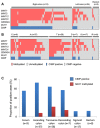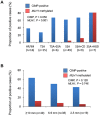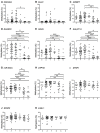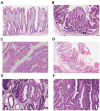Assessment of epigenetic alterations in early colorectal lesions containing BRAF mutations
- PMID: 27145369
- PMCID: PMC5085213
- DOI: 10.18632/oncotarget.9044
Assessment of epigenetic alterations in early colorectal lesions containing BRAF mutations
Abstract
To clarify the molecular and clinicopathological characteristics of colorectal serrated lesions, we assessed the DNA methylation of cancer-associated genes in a cohort of BRAF-mutant precancerous lesions from 94 individuals. We then compared those results with the lesions' clinicopathological features, especially colorectal subsites. The lesions included hyperplastic polyps (n = 16), traditional serrated adenomas (TSAs) (n = 15), TSAs with sessile serrated adenomas (SSAs) (n = 6), SSAs (n = 49) and SSAs with dysplasia (n = 16). The prevalence of lesions exhibiting the CpG island methylator phenotype (CIMP) was lower in the sigmoid colon and rectum than in other bowel subsites, including the cecum, ascending, transverse and descending colon. In addition, several cancer-associated genes showed higher methylation levels within lesions in the proximal to sigmoid colon than in the sigmoid colon and rectum. These results indicate that the methylation status of lesions with BRAF mutation is strongly associated with their location, histological findings and neoplastic pathways. By contrast, no difference in aberrant DNA methylation was observed in normal-appearing background colonic mucosa along the bowel subsites, which may indicate the absence of an epigenetic field defect.
Keywords: BRAF; CpG island methylator phenotype; colorectal cancer; methylation; serrated lesion.
Conflict of interest statement
All authors declare no conflicts of interest.
Figures





Similar articles
-
Significance of gene mutations in the Wnt signaling pathway in traditional serrated adenomas of the colon and rectum.PLoS One. 2020 Feb 24;15(2):e0229262. doi: 10.1371/journal.pone.0229262. eCollection 2020. PLoS One. 2020. PMID: 32092099 Free PMC article.
-
MicroRNA-31 expression in relation to BRAF mutation, CpG island methylation and colorectal continuum in serrated lesions.Int J Cancer. 2014 Dec 1;135(11):2507-15. doi: 10.1002/ijc.28920. Epub 2014 Apr 30. Int J Cancer. 2014. PMID: 24752710
-
Comparison of microsatellite instability, CpG island methylation phenotype, BRAF and KRAS status in serrated polyps and traditional adenomas indicates separate pathways to distinct colorectal carcinoma end points.Am J Surg Pathol. 2006 Dec;30(12):1491-501. doi: 10.1097/01.pas.0000213313.36306.85. Am J Surg Pathol. 2006. PMID: 17122504
-
The case for a genetic predisposition to serrated neoplasia in the colorectum: hypothesis and review of the literature.Cancer Epidemiol Biomarkers Prev. 2006 Oct;15(10):1778-84. doi: 10.1158/1055-9965.EPI-06-0164. Cancer Epidemiol Biomarkers Prev. 2006. PMID: 17035382 Review.
-
CpG Island Methylator Phenotype-High Colorectal Cancers and Their Prognostic Implications and Relationships with the Serrated Neoplasia Pathway.Gut Liver. 2017 Jan 15;11(1):38-46. doi: 10.5009/gnl15535. Gut Liver. 2017. PMID: 27885175 Free PMC article. Review.
Cited by
-
Genetic Biopsy for Prediction of Surveillance Intervals after Endoscopic Resection of Colonic Polyps: Results of the GENESIS Study.United European Gastroenterol J. 2018 Mar;6(2):290-299. doi: 10.1177/2050640617723810. Epub 2017 Jul 28. United European Gastroenterol J. 2018. PMID: 29511559 Free PMC article.
-
Significance of gene mutations in the Wnt signaling pathway in traditional serrated adenomas of the colon and rectum.PLoS One. 2020 Feb 24;15(2):e0229262. doi: 10.1371/journal.pone.0229262. eCollection 2020. PLoS One. 2020. PMID: 32092099 Free PMC article.
-
Relevance of gene mutations and methylation to the growth of pancreatic intraductal papillary mucinous neoplasms based on pyrosequencing.Sci Rep. 2022 Jan 10;12(1):419. doi: 10.1038/s41598-021-04335-z. Sci Rep. 2022. PMID: 35013462 Free PMC article.
-
Clinical, Pathological, and Molecular Characteristics of CpG Island Methylator Phenotype in Colorectal Cancer: A Systematic Review and Meta-analysis.Transl Oncol. 2018 Oct;11(5):1188-1201. doi: 10.1016/j.tranon.2018.07.008. Epub 2018 Jul 30. Transl Oncol. 2018. PMID: 30071442 Free PMC article.
-
Global differences in the prevalence of the CpG island methylator phenotype of colorectal cancer.BMC Cancer. 2019 Oct 17;19(1):964. doi: 10.1186/s12885-019-6144-9. BMC Cancer. 2019. PMID: 31623592 Free PMC article.
References
-
- Issa JP. Colon cancer: It's CIN or CIMP. Clin Cancer Res. 2008;14:5939–5940. - PubMed
-
- Fearon ER, Vogelstein B. A genetic model for colorectal tumorigenesis. Cell. 1990;61:759–767. - PubMed
-
- Weisenberger DJ, Siegmund KD, Campan M, Young J, Long TI, Faasse MA, Kang GH, Widschwendter M, Weener D, Buchanan D, Koh H, Simms L, Barker M, et al. CpG island methylator phenotype underlies sporadic microsatellite instability and is tightly associated with BRAF mutation in colorectal cancer. Nat Genet. 2006;38:787–793. - PubMed
MeSH terms
Substances
LinkOut - more resources
Full Text Sources
Other Literature Sources
Medical
Research Materials

